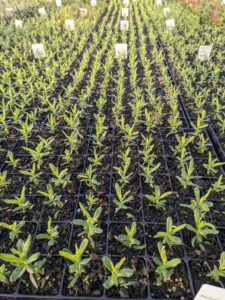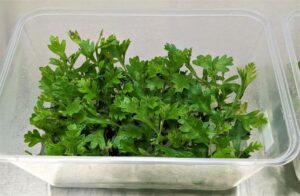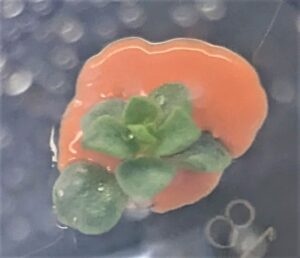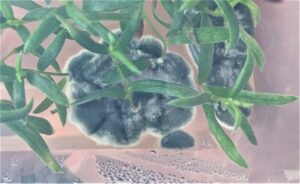
Life after the laboratory
By Lisa Wightwick
Plant propagation is fostered by a vision of potential. We may only be involved at the very beginning of a plant’s journey, but we look towards the future with the hope they flourish and have a positive impact on the world around them. Sometimes this future is not always certain for tissue culture (TC) plants –challenges in logistics, handling and acclimatisation can lead to poor success rates, discouraging growers from utilising them. With the information ahead, I hope to connect the worlds of the laboratory and nursery, providing end users with a better understanding of tissue culture plants, and advice to cultivate success.
Purchasing
- Seek reputable suppliers – choose Australian where possible. If importing, make sure the supplier provides mandatory documents such as import permits and phytosanitary certificates. The Department of Agriculture, Fisheries and Forestry website has guidelines for importing live plants.
- Open communication with Australian Quarantine/Import Brokers assists in the event of issues during inspection and allows importers to keep abreast of any delays. Inspection issues can cause excessive delays, and, in some cases, stock may be destroyed if contaminated or suspected to be a prohibited species.
- International suppliers that conduct business in Australia are bound by Australian Consumer Laws and must take accountability for the stock they export
- To reduce shipping volume and help evade quarantine issues (no media = no visible fungi, bacteria etc.) many international suppliers will pre-deflask the plants and seal them into bags. Unfortunately, this deprives the plant of its nutrient and water sources, and they may arrive under stress.

Delivery
- Request that shipments arrive at the start of the working week. Suppliers are usually flexible and can arrange this. Having the stock arrive early in the week benefits production
- Take caution when buying in over summer. Temperatures in transit are generally not regulated, and exceeding 30°C can cause irreversible damage to the plants. Time the shipping for cooler periods and request insulated boxes with cooling packs.
- Couriers are notorious for mishandling parcels despite labelling. If packages arrive damaged, take photographs and contact the supplier immediately. Courier services may be obligated to compensate for damage or loss of deliveries.
- Always check your TC products at delivery. Verify quantities, examine plant quality and health, and document progress.
- Timing is important. Plants should be deflasked as soon as they are received. The longer the time between the laboratory and acclimatisation environments, the higher the chances of decline in quality, health and survival.

The product
- Good quality cultures yield good results. TC plants should have consistent root growth, healthy foliage and sterile media. Look out for any significant browning of the leaves (occasional browning of the basal leaves can be normal), tips or dying plants. TC plants should be of a big enough size that they can be planted into a mix without disappearing. excessively tall plants can wilt and deform.
- Bacteria, fungus and algae contamination can have undesirable effects on TC growth and survival. Check incoming cultures (if still in their original containers) for any colourful, textured blotches. Bacteria usually has a shiny appearance and forms circular patterns, typically on the surface of the media. Fungus has a powdery appearance and can grow on top of, and through the media. Algae is characterised by its bright green colour and similar texture to bacteria.
- Contamination is not always detrimental to TC plants and successful deflasking can still be achieved by implementing a few simple strategies:
- Check the health of the plants. Any rotting, dying material will indicate that the contamination is negatively impacting the plants. Contamination can also hinder root growth. Compare clean/contaminated cultures side by side to get a good idea if the health is affected.
2. Dispose of severely contaminated/affected stock.
3. Separate and deflask contaminated cultures last, this will decrease the chance of cross contaminating clean plants. Label contaminated stock.
4. Take personal safety precautions such as wearing gloves, eye protection and masks when handling contaminated stock.
5. Remove as much of the gel medium from TC as possible; bacteria and fungi feed on this.
6. Avoid deflasking cultures containing fungal contamination in areas with high air flow. Fungal spores can become airborne and spread.
7. TC stock can be treated with a variety of different bactericidal and fungicidal products.

Deflasking and acclimatisation
- Trimming vegetation and roots of TC plants may be necessary but risky. Cut ends are like open wounds, increasing the risk to an already vulnerable plant. Avoid trimming TC material until hardening is complete. If trimming is unavoidable, use sterile tools. Trialling a small amount of stock is a good idea to minimise loss.
- Deflasking should be carried out with consideration to ambient temperature and humidity. Generally, humidity should be kept as high as possible and the temperature below 25°C. High temperature has a greater impact on transpiration regardless of the humidity level, even in high levels of humidity. TC plants exposed to overly hot conditions lose water significantly faster (TC plants lack defenses against water loss).
- Wilting of certain species can be a common and damaging issue, some remedies include use of anti-transpirants, deflasking in cool environments and frequent misting of TC plants with water while deflasking.
- General hygiene practices are important both during deflasking and acclimatisation. Deflasking stations should be thoroughly cleaned before and after use, tools should be sterilised frequently, and workers should wear gloves (for hygiene and safety). In the greenhouse, air circulation helps to minimise fungal growth (botrytis etc.). Regularly cleaning greenhouse benches etc., helps prevent cross-contamination. Check plants and substrate for any fungal or algal growth; these can quickly overcome the TC and must be treated with appropriate measures.
- Take care if using any plant growth regulators on TC plants that don’t have roots. Applying auxins can potentially have detrimental effects. Prior to leaving the lab, cultures are grown on media containing auxins, but can fail to grow roots. Auxins applied at deflasking may have a compounding effect with the auxins already absorbed, and can result in negative impacts to the plants.
- Dispose of culture containers responsibly. If stock is sent in plastic containers, empty the contents and place in the appropriate bin. If marked with the recycling number 5, the plastic can be recycled through the PP5 initiative.
- Seasonality can impact the success of acclimatisation. Extreme temperatures can result in failure, so schedule TC shipments in appropriate seasons for each species.
- Check on the plants at weekly intervals post-deflasking. Identify and treat any issues that may arise and make necessary changes to their environment as needed. Changes to humidity, temperature and light are generally made at weekly to fortnightly intervals.
- Research and trials are the best starting point when dealing with anything. Existing protocols and information can be utilised and improved upon by undertaking trials. The bigger the database of information, the better.

It’s my hope that these tips may enlighten and even prove useful to those who currently utilise plant tissue culture, those who may be considering it, or who are simply even passionate and interested growers. Understanding is one of the most critical tools for success in any field. The more we know about something, the greater and more economical we can be when working with it.
Lisa Wightwick
Plant Tissue Culture and
Micropropagation Specialist
Peninsula Growers
